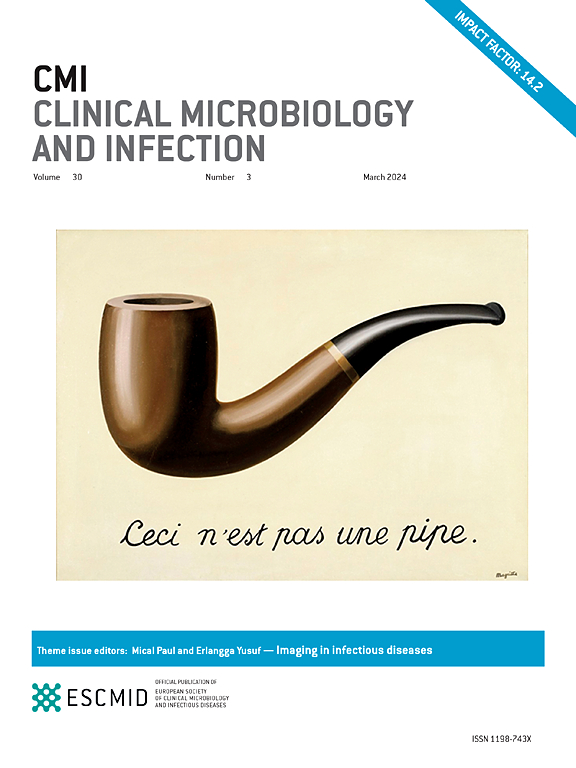妊娠期百日咳疫苗接种的安全性和婴儿的有效性:2019-2023年丹麦国家队列研究
IF 10.9
1区 医学
Q1 INFECTIOUS DISEASES
引用次数: 0
摘要
目的:最近百日咳传播的激增重新引起了对百日咳疫苗接种策略的关注。丹麦于2019年在怀孕期间实施百日咳疫苗接种,以保护三个月以下的婴儿。这项全国性的研究评估了妊娠期间接种无细胞百日咳疫苗的安全性和有效性。方法:使用丹麦全国登记资料,纳入2019年11月1日至2023年6月1日期间所有24孕周以上的妊娠和所有活产儿童,随访至2023年12月31日。产妇安全结局包括高血压、先兆子痫、绒毛膜羊膜炎、早产和死产。婴儿安全结局包括新生儿死亡率、新生儿重症监护病房入院和败血症。针对实验室确诊的百日咳和相关的医院接触者评估疫苗的有效性。为了产妇安全,根据妊娠天数、日历周和地区,接种疫苗的个体与未接种疫苗的个体进行1:1的匹配。在随访至3个月大的所有活产婴儿队列中评估婴儿结局。根据一系列人口、社会经济和医学特征对分析进行了调整。结果:在怀孕期间接种疫苗的50851名和未接种疫苗的50851名个体中,初步分析显示百日咳疫苗接种后高血压和先兆子痫的风险增加。然而,在调整了妊娠期流感和Covid-19疫苗接种后,百日咳疫苗接种与任何孕产妇安全结局的风险增加无关,包括高血压(发病率比(IRR) 0.98, 0.94-1.02)、轻度子痫前期(0.97,0.92-1.02)、严重子痫前期或HELLP综合征(0.95,0.86-1.05)。在215,974名活产儿童中,108,350人接种了疫苗。疫苗接种与婴儿不良结局无关,对实验室确认的百日咳的有效性为72%(42%-87%)(9对32)。结论:妊娠期接种百日咳疫苗可有效预防婴儿百日咳,且与不良妊娠或婴儿结局无关。然而,未来的研究应该检查其他疫苗或在怀孕期间接种多种疫苗是否会增加孕妇妊娠期高血压疾病的风险。本文章由计算机程序翻译,如有差异,请以英文原文为准。
Safety of pertussis vaccination in pregnancy and effectiveness in infants: a Danish national cohort study 2019–2023
Objectives
Recent surges in pertussis spread have renewed focus on pertussis vaccination strategies. Denmark implemented pertussis vaccination during pregnancy in 2019 to protect infants under 3 months. This nationwide study assessed the real-world safety and effectiveness of acellular pertussis vaccination during pregnancy.
Methods
Using nationwide Danish registers, we included all pregnancies beyond 24 gestational weeks and all liveborn children from November 1, 2019, to June 1, 2023, with follow-up until December 31, 2023. Maternal safety outcomes included hypertension, preeclampsia, chorioamnionitis, preterm birth, and stillbirth. Infant safety outcomes included neonatal mortality, neonatal intensive care unit admission, and sepsis. Vaccine effectiveness was evaluated against laboratory-confirmed pertussis and related hospital contacts. For maternal safety, vaccinated individuals were matched 1:1 to unvaccinated individuals based on gestational days, calendar week, and region. Infant outcomes were assessed among the cohort of all liveborn children with follow-up until 3 months of age. Analyses were adjusted for a range of demographic, socioeconomic and medical characteristics.
Results
Among 50 851 vaccinated and 50 851 unvaccinated individuals during pregnancy, initial analyses showed an increased risk of hypertension and preeclampsia after pertussis vaccination. However, after adjusting for influenza and COVID-19 vaccination during pregnancy, pertussis vaccination was not associated with increased risks of any maternal safety outcomes including hypertension (incidence rate ratio 0.98, 0.94–1.02), mild preeclampsia (0.97, 0.92–1.02), and severe preeclampsia or haemolysis, elevated liver enzymes, and low platelets (HELLP) syndrome (0.95, 0.86–1.05). Among 215 974 liveborn children, 108 350 were exposed to the vaccine. Vaccination was not associated with adverse infant outcomes and yielded a 72% (42–87%) effectiveness against laboratory-confirmed pertussis (9 vs. 32 events).
Discussion
Pertussis vaccination in pregnancy was effective in preventing infant pertussis and was not associated with adverse pregnancy or infant outcomes. Future studies should, however, examine whether other vaccines or the administration of multiple vaccines during pregnancy pose an increased maternal risk of hypertensive disorders in pregnancy.
求助全文
通过发布文献求助,成功后即可免费获取论文全文。
去求助
来源期刊
CiteScore
25.30
自引率
2.10%
发文量
441
审稿时长
2-4 weeks
期刊介绍:
Clinical Microbiology and Infection (CMI) is a monthly journal published by the European Society of Clinical Microbiology and Infectious Diseases. It focuses on peer-reviewed papers covering basic and applied research in microbiology, infectious diseases, virology, parasitology, immunology, and epidemiology as they relate to therapy and diagnostics.

 求助内容:
求助内容: 应助结果提醒方式:
应助结果提醒方式:


